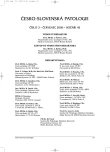Biochemical and Immunohistochemical Markers of Brain Injury
Authors:
D. Vajtr 1,3; R. Průša 1; L. Houšťava 2; F. Šámal 2; J. Kukačka 1; J. Pachl 4
Authors‘ workplace:
Ústav klinické biochemie a patobiochemie UK 2. LF a FN Motol
1; Neurochirurgická klinika UK 3. LF a FNKV
2; Oddělení soudního lékařství, Nemocnice Sokolov
3; Klinika anesteziologie a resuscitace UK 3. LF a FNKV
4
Published in:
Soud Lék., 51, 2006, No. 3, p. 36-41
Overview
Proteins released to circulation from affected tissues during primary or secondary trauma brain injury might be used as serum markers of glial or ganglial cells damage (neuron specific enolasis and S100 B protein). Other markers of trauma can be proved as relatively specific of diffuse axonal injury by immunohistochemical detectoin (amyloid prekurzor protein, neuron specific enolasis, glial fibrilar acidic protein and superficial antigen receptor CD 68). Some markers are associated with blood brain barrier damage (matrix metaloproteinases (MMP-2, MMP-9) and synthase of nitric oxide (iNOS)).
We aimed in our short communication on biomechanics of developed of trauma, primary or secondary kinds of trauma brain injury and use of trauma brain injury markers for clinical diagnostics and management of patients.
Key words:
contusion – diffuse axonal injury – neuron specific enolasis – S-100B protein.
Labels
Anatomical pathology Forensic medical examiner ToxicologyArticle was published in
Forensic Medicine

2006 Issue 3
Most read in this issue
- Biochemical and Immunohistochemical Markers of Brain Injury
- A Fatal Case of Saponated Cresol Ingestion
- Using of Scanning Electron Microscopy for Detection of Gunshot Residue
